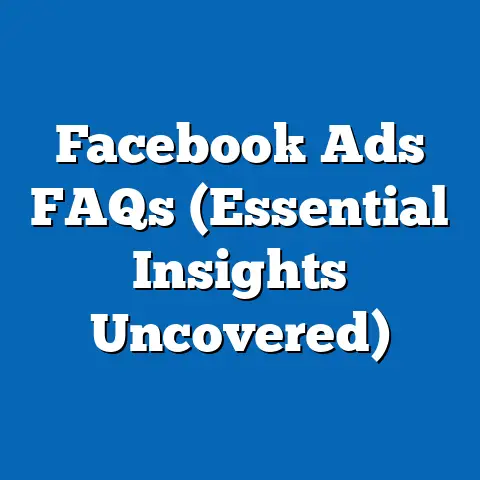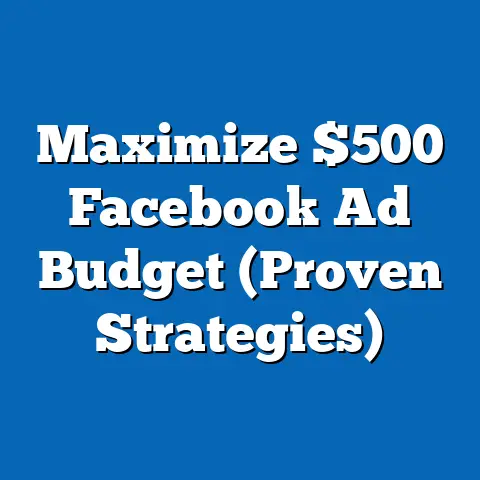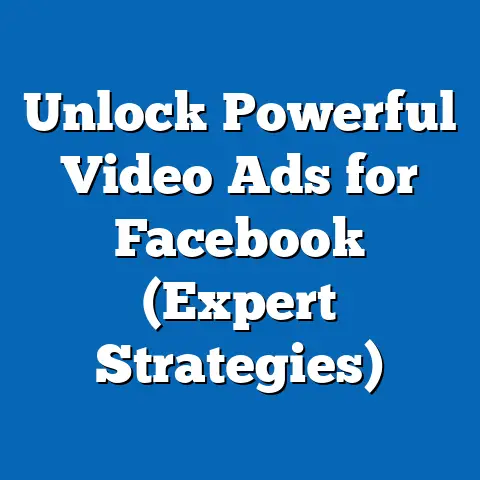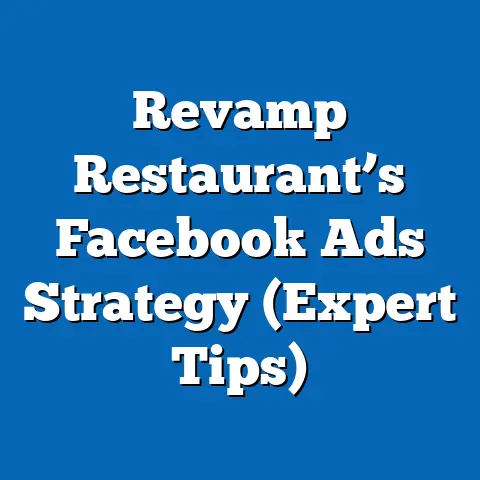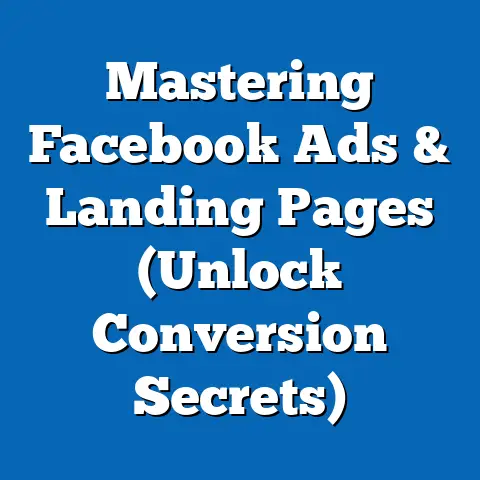Boost Facebook Group with Targeted Ads (Pro Strategies)
Crafting Community: Pro Strategies to Boost Your Facebook Group with Targeted Ads
In today’s digital world, building a successful Facebook Group is like being a skilled artisan. It’s not just about creating a space; it’s about fostering a community where members connect, collaborate, and grow together. A well-cultivated group can be a powerful tool for connection, collaboration, and even business growth. But how do you get the right people to join your group? That’s where targeted ads come in. I’ve learned that the key to a thriving Facebook Group lies in attracting the right audience, and targeted ads are the secret weapon. Over the years, I’ve experimented with countless strategies, and I’m excited to share some of the most effective techniques I’ve discovered. Get ready to dive into the world of pro strategies that will amplify your group’s visibility and turn it into a vibrant hub of activity. Let’s get started!
Understanding Your Audience
Before you even think about launching ads, you need to know who you’re trying to reach. This isn’t just about guessing; it’s about understanding your audience inside and out. I’ve seen too many campaigns fail because they didn’t start with a solid understanding of the target audience.
Creating Audience Personas
One of the best ways to get to know your audience is by creating audience personas. Think of these as fictional representations of your ideal group members. What are their demographics? What are their interests and behaviors?
For example, if you’re running a group about vegan cooking, your audience persona might be “Vegan Vanessa,” a 30-year-old woman who loves experimenting with new recipes, cares about animal welfare, and is active on social media. Another persona could be “Eco-Conscious Ethan,” a 45-year-old man who’s passionate about sustainable living and enjoys sharing tips with others.
By creating these personas, you can start to visualize your target audience and tailor your ad content to their specific needs and desires.
Leveraging Facebook’s Audience Insights Tool
Facebook’s Audience Insights tool is a goldmine of data. It allows you to gather valuable information about your target audience, including their demographics, interests, behaviors, and even their purchasing habits.
I remember when I first discovered this tool, I was blown away by the level of detail it provided. I was able to see exactly what other pages my target audience liked, what topics they were interested in, and even what devices they were using.
To use Audience Insights, go to your Ads Manager and select “Audience Insights” from the menu. From there, you can start exploring different demographics, interests, and behaviors to get a better understanding of your target audience.
Addressing Pain Points and Desires
Understanding your audience’s pain points and desires is crucial for shaping your ad strategy. What problems are they trying to solve? What are their aspirations?
For example, if your Facebook Group is about parenting, your audience’s pain points might include feeling overwhelmed, struggling with discipline, or lacking support. Their desires might include wanting to raise happy, well-adjusted children, connecting with other parents, and finding helpful resources.
By addressing these pain points and desires in your ad content, you can create ads that resonate with your target audience and compel them to join your group.
Takeaway: Before launching any ads, take the time to understand your audience. Create audience personas, leverage Facebook’s Audience Insights tool, and address their pain points and desires. This will lay the foundation for a successful ad strategy.
Crafting Compelling Ad Content
Now that you know your audience, it’s time to create ad content that grabs their attention and convinces them to join your group. This is where the magic happens. I’ve learned that compelling ad content is the key to driving group membership.
Elements of High-Performing Ad Content
High-performing ad content typically includes:
- Attention-grabbing headlines: Your headline is the first thing people will see, so it needs to be attention-grabbing and relevant.
- Engaging visuals: Visuals are just as important as headlines. Use high-quality images or videos that capture attention and convey your message.
- Clear calls-to-action: Tell people exactly what you want them to do. Use clear and concise calls-to-action like “Join Our Group Now” or “Learn More.”
I once ran an ad campaign for a photography group, and the ad featured a stunning image of a sunset landscape with the headline “Capture the Beauty of the World.” The call-to-action was “Join Our Photography Community.” This ad performed incredibly well because it combined an attention-grabbing visual with a clear call-to-action.
Aligning Ad Content with Group Values
Your ad content should align with the values and purpose of your Facebook Group. What is your group all about? What kind of community are you trying to build?
If your group is about supporting small businesses, your ad content should focus on the benefits of joining a supportive community of entrepreneurs. If your group is about promoting sustainable living, your ad content should focus on the benefits of connecting with like-minded individuals who are passionate about protecting the environment.
Examples of Successful Ad Copy and Visuals
Here are a few examples of successful ad copy and visuals that have effectively driven group membership:
- Ad Copy: “Are you a busy mom looking for support and connection? Join our Facebook Group and connect with other moms who understand what you’re going through.”
- Visual: A photo of a group of moms laughing and chatting together.
- Ad Copy: “Do you love hiking and exploring the great outdoors? Join our Facebook Group and discover new trails, share your adventures, and connect with fellow hikers.”
- Visual: A video of hikers enjoying a scenic trail.
The Role of Storytelling
Storytelling is a powerful tool for creating ads that resonate with potential group members. Share stories about how your group has helped people, how it has created meaningful connections, or how it has made a positive impact on the world.
I remember reading a story about a woman who joined a Facebook Group for cancer survivors. She said that the group had been a lifeline for her, providing her with support, encouragement, and a sense of community during a difficult time. Stories like these can be incredibly powerful in attracting new members to your group.
Takeaway: Craft compelling ad content that grabs attention, aligns with your group’s values, and tells a story. Use attention-grabbing headlines, engaging visuals, and clear calls-to-action.
Choosing the Right Ad Format
Facebook offers a variety of ad formats, each with its own strengths and weaknesses. Choosing the right ad format is crucial for promoting your Facebook Group effectively.
Overview of Ad Formats
Here’s a quick overview of some of the most popular ad formats:
- Image Ads: Simple and effective, image ads feature a single image or graphic.
- Video Ads: Engaging and dynamic, video ads can capture attention and tell a story.
- Carousel Ads: Versatile and informative, carousel ads allow you to showcase multiple images or videos in a single ad.
- Slideshow Ads: Lightweight and easy to create, slideshow ads combine multiple images into a video-like format.
Strengths and Weaknesses of Each Format
- Image Ads:
- Strengths: Easy to create, cost-effective, and suitable for simple messages.
- Weaknesses: Can be less engaging than other formats, limited storytelling potential.
- Video Ads:
- Strengths: Highly engaging, can tell a story, and capture attention.
- Weaknesses: Can be more expensive to produce, requires more effort to create.
- Carousel Ads:
- Strengths: Versatile, can showcase multiple products or features, and tell a story.
- Weaknesses: Can be overwhelming if not well-designed, requires more planning.
- Slideshow Ads:
- Strengths: Lightweight, easy to create, and suitable for showcasing multiple images.
- Weaknesses: Can be less engaging than video ads, limited storytelling potential.
- Strengths: Easy to create, cost-effective, and suitable for simple messages.
- Weaknesses: Can be less engaging than other formats, limited storytelling potential.
- Strengths: Highly engaging, can tell a story, and capture attention.
- Weaknesses: Can be more expensive to produce, requires more effort to create.
- Strengths: Versatile, can showcase multiple products or features, and tell a story.
- Weaknesses: Can be overwhelming if not well-designed, requires more planning.
- Strengths: Lightweight, easy to create, and suitable for showcasing multiple images.
- Weaknesses: Can be less engaging than video ads, limited storytelling potential.
When to Use Specific Formats
- Image Ads: Use image ads when you have a simple message to convey and want to keep costs low.
- Video Ads: Use video ads when you want to tell a story, capture attention, and engage your audience.
- Carousel Ads: Use carousel ads when you want to showcase multiple products or features, or tell a story in a sequential manner.
- Slideshow Ads: Use slideshow ads when you want to showcase multiple images without the cost and effort of creating a video.
Case Studies and Success Stories
I’ve seen some incredible results with different ad formats. For example, a travel group used a carousel ad to showcase stunning photos of different destinations, and their membership skyrocketed. A cooking group used a video ad to share a quick recipe tutorial, and they saw a huge increase in engagement.
Takeaway: Choose the right ad format based on your message, budget, and creative resources. Consider using video ads for engaging storytelling, carousel ads for showcasing multiple products or features, and image ads for simple messages.
Setting Up Your Targeted Ads Campaign
Now that you have your ad content and format ready, it’s time to set up your targeted ads campaign. This is where you’ll define your audience, set your budget, and launch your ads.
Step-by-Step Process
- Go to Facebook Ads Manager: Log in to your Facebook account and go to Ads Manager.
- Create a New Campaign: Click on the “Create” button to start a new campaign.
- Choose Your Objective: Select the right objective for your campaign. For boosting group membership, “Engagement” or “Traffic” are good options.
- Define Your Audience: Use Facebook’s targeting options to define your audience based on demographics, interests, behaviors, and more.
- Set Your Budget: Determine how much you’re willing to spend on your campaign. You can set a daily budget or a lifetime budget.
- Choose Your Ad Placement: Select where you want your ads to appear. Facebook, Instagram, and Audience Network are all options.
- Create Your Ad: Upload your ad content, write your ad copy, and add a call-to-action.
- Review and Publish: Review your campaign settings and publish your ad.
Selecting the Right Objectives
Choosing the right objective is crucial for the success of your campaign. If you want to drive traffic to your Facebook Group, select the “Traffic” objective. If you want to increase engagement within your group, select the “Engagement” objective.
Budget Allocation, Ad Scheduling, and Bid Strategies
- Budget Allocation: Determine how much you’re willing to spend on your campaign. Start with a small budget and gradually increase it as you see results.
- Ad Scheduling: Choose when you want your ads to run. Consider scheduling your ads to run during peak hours when your target audience is most active on Facebook.
- Bid Strategies: Select the right bid strategy for your campaign. Automatic bidding is a good option for beginners, while manual bidding allows you to have more control over your bids.
A/B Testing Ad Variations
A/B testing is the process of testing different ad variations to see which ones perform best. Test different headlines, visuals, and calls-to-action to see what resonates with your audience.
I always recommend A/B testing to my clients. It’s the best way to optimize your ad campaigns and get the most out of your budget.
Takeaway: Set up your targeted ads campaign carefully, selecting the right objectives, defining your audience, and setting your budget. A/B test different ad variations to see what resonates best with your audience.
Monitoring and Optimizing Your Ads
Once your ads are running, it’s important to monitor their performance and make adjustments as needed. This is an ongoing process that requires attention and analysis.
Tracking Ad Performance with Facebook Ads Manager
Facebook Ads Manager provides a wealth of data about your ad performance. You can track metrics like impressions, clicks, reach, and cost per conversion.
Key Metrics to Monitor
- Click-Through Rate (CTR): The percentage of people who click on your ad after seeing it.
- Conversion Rate: The percentage of people who take the desired action after clicking on your ad (e.g., joining your Facebook Group).
- Cost Per Conversion: The cost of acquiring one new member to your Facebook Group.
Interpreting Data and Making Adjustments
If your CTR is low, it means that your ad isn’t grabbing attention. Try testing different headlines and visuals to see if you can improve your CTR. If your conversion rate is low, it means that people aren’t taking the desired action after clicking on your ad. Try improving your ad copy and call-to-action to see if you can increase your conversion rate.
Best Practices for Ongoing Optimization
- Monitor your ads daily: Check your ad performance regularly to see how your ads are performing.
- Make small adjustments: Don’t make drastic changes to your ads. Make small adjustments and see how they affect your performance.
- Test different variations: Continue to test different ad variations to see what resonates best with your audience.
- Stay up-to-date: Stay up-to-date on the latest Facebook advertising trends and best practices.
Takeaway: Monitor and optimize your ads regularly to ensure sustained growth of your Facebook Group. Track key metrics, interpret data, and make adjustments as needed.
Conclusion
Boosting a Facebook Group with targeted ads is more than just a numbers game; it’s about crafting a thriving community. By understanding your audience, creating compelling ad content, choosing the right ad format, setting up your campaign carefully, and monitoring your results, you can unlock the potential for growth and engagement within your group. I encourage you to take actionable steps based on the strategies we’ve discussed and witness your Facebook Group flourish. The potential for growth and engagement is within your reach, so go out there and make it happen!

